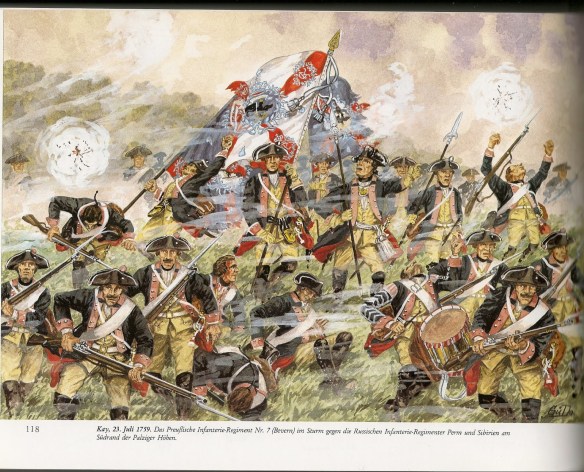The Battle of Kay (German: Schlacht bei Kay), also referred to as the Battle of Sulechów or Battle of Paltzig, was a battle fought on 23 July 1759 during the Seven Years’ War. It occurred near Kay (Kije) in the Neumark, now part of Poland.
The Battle of Paltzig signified Russia’s emergence as a legitimate military power and a nation of influence on the international scene. Also known as the Battle of Kay, the Battle of Paltzig was a battle fought between the Russian army of Empress Elizabeth and the Prussian army of King Frederick II (the Great) in the summer of 1759, as part of the Seven Years War (1756- 1763). After suffer- ing heavy losses at the Battle of Zorndorf in August 1758, the Russian army, now under its third commander in three years, Field Marshal Count Pyotr Semenovich Saltykov- was under orders from Elizabeth to begin its third offensive of the war. Though in his 60s, Field Marshal Saltykov was a more aggressive and skilled field commander than his predecessors had been and immediately began a methodical advance westward into Prussia in June 1759 with an army of 41,000 men (although some estimates have the Russian army at 70,000 men). King Frederick II ordered General Richard van Wedell, with a 26,000- man army, to stop the westward advance of the Russian army.
Meanwhile, the main Prussian army under Frederick II remained engaged with the Austrian army to the south, to prevent it from joining forces with the Russians. After the Russian army crossed into Prussian territory, General Wedell unwisely and rashly launched a frontal attack on Field Marshal Saltykov’s well- prepared Russian forces at Paltzig, just inside the Prussian border on July 23, 1759. Repeated assaults into the Russian positions resulted in the slaughter of the Prussian army under General Wedell and a stinging defeat for Frederick II. The Prussians lost 6,000 to 8,300 men, the Russians less than 5,000.
His forces rendered ineffective, General Wedell retreated across the Oder River. The defeat of his army at Paltzig forced Frederick II to rush north with 43,000 men to take over the defense against the Russian army personally and try to force the Russians into a decisive engagement. After the Battle of Paltzig, the Russian army built fortified positions around the village of Kunersdorf on the Oder River, opposite Frankfurt. Frederick’s task of winning for a decisive engagement with the Russian army became even more daunting when the Austrian commander, Count von Daun, sent a force of 35,000 men from Saxony to join the Russians.
